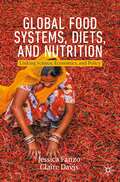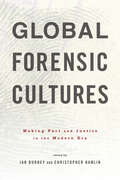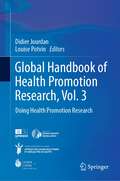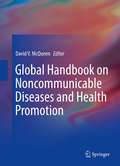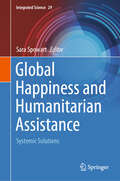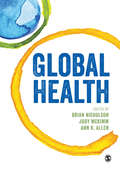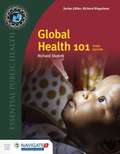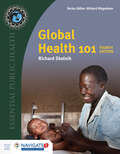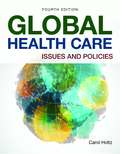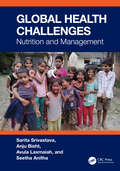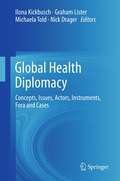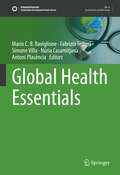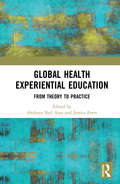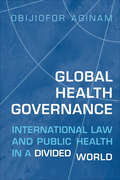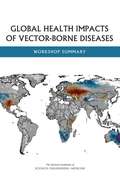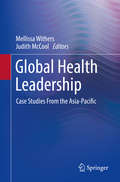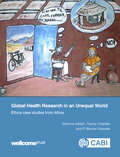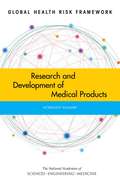- Table View
- List View
Global Food Systems, Diets, and Nutrition: Linking Science, Economics, and Policy (Palgrave Studies in Agricultural Economics and Food Policy)
by Claire Davis Jessica FanzoEnsuring optimal diets and nutrition for the global population is a grand challenge fraught with many contentious issues. To achieve food security for all and protect health, we need functional, equitable, and sustainable food systems. Food systems are highly complex networks of individuals and institutions that depend on governance and policy leadership. This book explains how interconnected food systems and policies affect diets and nutrition in high-, middle-, and low-income countries. In tandem with food policy, food systems determine the availability, affordability, and nutritional quality of the food supply, which influences the diets that people are willing and able to consume. Readers will become familiar with both domestic and international food policy processes and actors, and they will be able to critically analyze and debate how policy and science affect diet and nutrition outcomes.
Global Forensic Cultures: Making Fact and Justice in the Modern Era
by Ian Burney and Christopher HamlinEssays explore forensic science in global and historical context, opening a critical window onto contemporary debates about the universal validity of present-day genomic forensic practices.Contemporary forensic science has achieved unprecedented visibility as a compelling example of applied expertise. But the common public view—that we are living in an era of forensic deliverance, one exemplified by DNA typing—has masked the reality: that forensic science has always been unique, problematic, and contested. Global Forensic Cultures aims to rectify this problem by recognizing the universality of forensic questions and the variety of practices and institutions constructed to answer them.Groundbreaking essays written by leaders in the field address the complex and contentious histories of forensic techniques. Contributors also examine the co-evolution of these techniques with the professions creating and using them, with the systems of governance and jurisprudence in which they are used, and with the socioeconomic, political, racial, and gendered settings of that use. Exploring the profound effect of "location" (temporal and spatial) on the production and enactment of forms of forensic knowledge during the century before CSI became a household acronym, the book explores numerous related topics, including the notion of burden of proof, changing roles of experts and witnesses, the development and dissemination of forensic techniques and skills, the financial and practical constraints facing investigators, and cultures of forensics and of criminality within and against which forensic practitioners operate.Covering sites of modern and historic forensic innovation in the United States, Europe, and farther-flung imperial and global settings, these essays tell stories of blood, poison, corpses; tracking persons and attesting documents; truth-making, egregious racism, and sinister surveillance. Each chapter is a finely grained case study. Collectively, Global Forensic Cultures supplies a historical foundation for the critical appraisal of contemporary forensic institutions which has begun in the wake of DNA-based exonerations.Contributors: Bruno Bertherat, José Ramón Bertomeu Sánchez, Binyamin Blum, Ian Burney, Marcus B. Carrier, Simon A. Cole, Christopher Hamlin, Jeffrey Jentzen, Projit Bihari Mukharji, Quentin (Trais) Pearson, Mitra Sharafi, Gagan Preet Singh, Heather Wolffram
Global Handbook of Health Promotion Research, Vol. 1: Mapping Health Promotion Research
by Louise Potvin Didier JourdanWhile research teams are producing relevant and valid knowledge for health promotion, there is not yet a structured manual and distinct field of health promotion research. This timely "state-of-the-art" handbook contributes to the structuring of such a field of research. This collection of original contributions explores the major epistemological, methodological, and ethical challenges facing health promotion research. It brings together experts from different "research traditions" that coexist in the field. The handbook covers the existing knowledge production and sharing practices to delineate the "discipline" and its agenda for future research. Ultimately, it contributes to the creation of a global community of health promotion researchers. The handbook is organized by four types of practices (what people actually do) studied in health promotion; the practices of: Individuals and populations in relation to their health and its determinantsProfessionals who intervene to improve population healthPolicy-makers and institutions involved in the advocacy, design, and implementation of policies and programsResearchers and innovators (academic scholars and global agencies) through which investment in research and production of evidence-based guidelines are made. Global Handbook of Health Promotion Research, Vol. 1: Mapping Health Promotion Research is a highly relevant reference tool for researchers and graduate students in health promotion, public health, education and socio-health sciences; practitioners in health, medical, and social sectors; policy-makers; and health research administrators.
Global Handbook of Health Promotion Research, Vol. 3: Doing Health Promotion Research
by Louise Potvin Didier JourdanWhile research teams are producing relevant and valid knowledge for health promotion, there is not yet a structured manual and distinct field of health promotion research. This timely "state-of-the-art" handbook contributes to structuring the field of health promotion research. This collection presents introductory-level methodological solutions to the major epistemological, methodological, and ethical challenges facing health promotion research. It brings together experts from different "research traditions" that coexist in the field. The handbook covers the existing knowledge production and sharing practices to delineate the "discipline" and its agenda for future research. Ultimately, it contributes to creating a global community of health promotion researchers. This volume concerns research practices relevant to the production and sharing of knowledge about health promotion practices. It is organized as follows: Part I presents some paradigms and approaches to knowledge production relevant to health promotion research. Parts II to V describe research designs and methods that specifically address health promotion research.Part VI includes an overview of the challenges facing health promotion research and suggests ways forward. Global Handbook of Health Promotion Research, Vol. 3: Doing Health Promotion Research is a highly relevant reference tool for researchers and graduate students in health promotion, public health, education, and socio-health sciences; practitioners in health, medical, and social sectors; policy-makers; and health research administrators.
Global Handbook on Noncommunicable Diseases and Health Promotion
by David V. McqueenSince the beginning of the 21st century, chronic diseases account for the majority of all deaths globally and represent an enormous financial burden on all countries, regardless of level of economic development. Originally defined as being long-term, generally incurable diseases of older persons, chronic diseases have increasingly been conceptualized as noncommunicable diseases (NCDs). These long-term afflictions are the leading health problems of the modern world and represent some of the greatest challenges to clinical, preventive medicine and health promotion at this time. Health promotion has arisen as an approach that is most critical in dealing with the broad array of causes of NCDs. Thus, this book addresses NCDs and health promotion in this global context. There is a widely recognized global incapacity to deal with chronic diseases. Furthermore, the needed capacity may vary enormously with level of development and multiple social and economic factors. Simple approaches that deal with single risk factors have enjoyed a modicum of success in some parts of the world, but today the salient opinion is that broad social and policy approaches are the long-term effective approaches. This book takes a critical perspective analyzing the relative success of recent and current approaches to addressing the challenges of the noncommunicable diseases in different social, economic, and political contexts. Because the extant literature addressing NCDs and health promotion appears to be primarily in the Western press and in an epidemiological context, this book makes every effort to offer discussions from other perspectives. Thus some of the sections of the book offer a lens or a critical perspective into the approach to chronic diseases. In addition each section addresses the state of the evidence for the effectiveness of the approach.
Global Happiness and Humanitarian Assistance: Systemic Solutions (Integrated Science #29)
by Sara SpowartThis book compiles concerning important solutions for current and future global challenges to wellbeing. The purpose of this book is to provide high-level, systems-thinking solutions to many relevant issues. Specifically, the most relevant identified concerns of depression, suicidal ideation, loneliness and isolation as identified by the World Organization are addressed. Other important topics that are addressed are global happiness, humanitarian challenges, physical health innovations, cultural norms and innovative solutions to improve well-being such as mental health literacy and reduced mental health stigma. This book is unique because it addresses health and wellbeing on a systems-based, solution and future-oriented perspective. A systems-based compilation of chapters is needed to improve well-being and address WHO concerns going forward. This systems-based approach should address a convergence of grassroots as well as large-scale concerns.
Global Health
by Brian D Nicholson Ann Allen Professor Judy McKimmThe concept of global health has moved on from focusing on the problems of the developing world to encompass health problems with global impact. Global health issues impact daily on local healthcare delivery and professional practice. This illuminating guide for healthcare students and practitioners introduces the major themes, challenges and debates relevant to global health that will equip the reader with the knowledge and skills required to thrive in this multi-faceted area of practice. Key features Puts global health in context considering key issues including health inequalities, human health and the global environment and climate change. Ideal reading for international electives, voluntary work, and further qualifications in global health. Contains insights from leading experts in the field. Relevant to those working in a culturally diverse context whether domestic or international.
Global Health
by Brian D Nicholson Professor Judy Mckimm Ann AllenThe concept of global health has moved on from focusing on the problems of the developing world to encompass health problems with global impact. Global health issues impact daily on local healthcare delivery and professional practice. This illuminating guide for healthcare students and practitioners introduces the major themes, challenges and debates relevant to global health that will equip the reader with the knowledge and skills required to thrive in this multi-faceted area of practice. Key features Puts global health in context considering key issues including health inequalities, human health and the global environment and climate change. Ideal reading for international electives, voluntary work, and further qualifications in global health. Contains insights from leading experts in the field. Relevant to those working in a culturally diverse context whether domestic or international.
Global Health 101
by Richard SkolnikRated by an independent panel as the best introductory Global Health text for undergraduates, Global Health 101, Third Edition is a clear, concise, and user-friendly introduction to the most critical issues in global health. It illustrates key themes with an extensive set of case studies, examples, and the latest evidence. Particular attention is given to the health-development link, to developing countries, and to the health needs of poor and disadvantaged people. The Third Edition is a thorough revision that offers an extensive amount of new and updated information, while maintaining clarity, simplicity, and ease of use for faculty and students. Offering the latest data on the burden of disease, the book presents unique content on key topics that are often insufficiently covered in introductory materials, such as immunization and adolescent health.
Global Health 101
by Richard SkolnikIn keeping with the previous edition – which was independently rated as the best global health book for undergraduates – Global Health 101, Fourth Edition is a clear, concise, and user-friendly introduction to the most critical issues in global health, illustrating key themes with an extensive set of case studies, examples, and the latest evidence. Drawing from his 40 years of experience working in international development and global health, as well as extensively teaching at both Yale and George Washington University, Richard Skolnik has substantially revised his bestselling textbook. This edition offers a significant amount of new and updated information, while maintaining the clarity, simplicity, and ease of use that has made this text so popular. Global Health 101, Fourth Edition builds in unique ways on evidence from a number of fundamental sources, including the Global Burden of Disease Studies, Disease Control Priorities, Third Edition, (DCP3), and Millions Saved.
Global Health Care: Issues and Policies
by Carol HoltzGlobal Health Care: Issues and Policies, Fourth Edition is a comprehensive resource for nursing students focused on critical and timely global health topics
Global Health Challenges: Nutrition and Management
by Sarita Srivastava Anju Bisht Avula Laxmaiah Anitha SeethaThis book is an up-to-date reference on some of the major global health issues and the role of nutrition in their prevention and management. The book covers undernutrition, degenerative diseases, mental health disorders and COVID-19 and reviews feeding and eating disorders like anorexia, bulimia, binge-eating, and delineates the risk factors and management. The book addresses the gaps in tackling these health problems and proposes comprehensive models and frameworks to manage them.Key Features: Explores practical solutions and management of looming health issues in terms of diet and nutrition Reviews health threats like obesity, diabetes, hypertension and COVID-19 Includes a section on feeding and eating disorders and sustainable models to manage them Covers mental-health issues like depression and dementia Discusses conditions like undernutrition, hidden hunger, and cardiovascular diseases The book is meant for health professionals, nutritionists, and policymakers. It is also useful for post-graduates in public health and nutrition.
Global Health Collaboration: Challenges And Lessons (SpringerBriefs in Public Health)
by Margaret S. Winchester Caprice A. Knapp Rhonda BeLueThis stimulating open access volume details the innovative work of the Pan Institution Network for Global Health in creating collaborative research-based answers to large-scale health issues. Equitable partnerships among member universities representing North America, Africa, Asia, and Europe reverse standard cross-national dynamics to develop locally relevant responses to health challenges as well as their underlying disparities. Case studies focusing on multiple morbidities and effects of urbanization on health illustrate open dialogue in addressing HIV, maternal/child health, diabetes, and other major concerns. These instructive examples model collaborations between global North and South as meaningful steps toward the emerging global future of public health. Included in the coverage: Building sustainable networks: introducing the Pan Institution Network for Global Health Fostering dialogues in global health education: a graduate and undergraduate approach Provider workload and multiple morbidities in the Caribbean and South Africa Project Redemption: conducting research with informal workers in New York City Partnership and collaboration in global health: valuing reciprocity Global Health Collaboration will interest faculty working within the field of global health; scholars within public health, health policy, and cognate disciplines; as well as administrators looking to develop international university partnerships around global health and graduate students in the areas of global health, health administration, and public health and related social sciences (e.g., sociology, anthropology, demography).
Global Health Communication for Immigrants and Refugees: Cases, Theories, and Strategies (Routledge Research in Health Communication)
by Do Kyun David KimThis book analyzes international cases of immigrants and refugees from a health communication perspective, providing theoretical frames and effective recommendations for designing future health communication campaigns and interventions for health promotion. Internationally renowned scholars elucidate the reality of health communication situations that immigrants and refugees experience in host countries around the globe and examine how national and global health risk situations, including the COVID-19 pandemic, affect immigrant and refugee health during difficult health circumstances. Offering effective health communication strategies for promoting immigrant and refugee health, the book also provides lessons learned from past and present health communication campaigns, responses of diverse communities, and governmental policies. Drawing on case studies from major host countries on different continents, this book will be of interest to anyone researching or studying in the areas of health communication, public health, international relations, public administration, nursing, and social work.
Global Health Diplomacy
by Nick Drager Ilona Kickbusch Michaela Told Graham ListerThe world's problems are indeed world problems: social and environmental crises, global trade and politics, and major epidemics are making public health a pressing global concern. From this constantly changing scenario, global health diplomacy has evolved, at the intersection of public health, international relations, law, economics, and management--a new discipline with transformative potential. Global Health Diplomacy situates this concept firmly within the human rights dialogue and provides a solid framework for understanding global health issues and their negotiation. This up-to-the-minute guide sets out defining principles and the current agenda of the field, and examines key relationships such as between trade and health diplomacy, and between global health and environmental issues. The processes of global governance are detailed as the UN, WHO, and other multinational actors work to address health inequalities among the world's peoples. And to ensure maximum usefulness, the text includes plentiful examples, discussion questions, reading lists, and a glossary. Featured topics include: The legal basis of global health agreements and negotiations. Global public goods as a foundation for global health diplomacy. Global health: a human security perspective. Health issues and foreign policy at the UN. National strategies for global health. South-south cooperation and other new models of development. A volume of immediate utility with a potent vision for the future, Global Health Diplomacy is an essential text for public health experts and diplomats as well as schools of public health and international affairs.
Global Health Disputes and Disparities: A Critical Appraisal of International Law and Population Health
by Dru BhattacharyaGlobal Health Disputes and Disparities explores inequalities in health around the world, looking particularly at the opportunity for, and limitations of, international law to promote population health by examining its intersection with human rights, trade, and epidemiology, and the controversial issues of legal process, religion, access to care, and the social context of illness. Using a theoretical framework rooted in international law, this volume draws on a wide range of rich empirical data to assess the challenges facing the field, including international legal treaty interpretation, and specific issues related to the application of law in resolving pressing issues in gender, access to care, and social determinants of health. In doing so, it illustrates the challenges for implementing rights-based approaches to address health disparities, with profound implications for future regulations and policymaking. It includes both interviews with leading scholars, as well as a variety of case studies from prominent international forums, including formal claims brought before the Human Rights Council and the Committee on the Elimination of All Forms of Discrimination Against Women, as well as regional and national experiences, drawn from disputes in India, Indonesia, South Africa and the USA. This volume is an innovative contribution to the burgeoning fields of global health and human rights, and will be of interest to students and researchers in public health, global health, law and sociology interested in the social determinants of health and social justice from both theoretical and practical perspectives.
Global Health Essentials (Sustainable Development Goals Series)
by Fabrizio Tediosi Mario C. B. Raviglione Simone Villa Núria Casamitjana Antoni PlasènciaThis practical and handy textbook offers a succinct yet comprehensive overview of the main challenges, issues and solutions in global health in relation to the UN’s Sustainable Development Goals (SDG) 2030 agenda. Subdivided into 11 parts, devoted each to a macro-topic, the book opens with an introduction to Global Health followed by an overview of the global burden of disease – from child and maternal health to communicable and non-communicable diseases. The authors further examine the social determinants of health, health systems’ features as well as innovations, governance and methods in Global Health. In consideration of the emerging discussions and ideas, and beyond the more traditional and essential elements of global health, the book also looks at the need to re-think the whole concept of global health and the importance of a “decolonized” approach that engages low and lower-middle countries fully. One entire part is then devoted to analyzing the major threats to the health of humanity such as climate change, the need for an ecological approach to health (including “One Health” approaches), and, ultimately, planetary health. Written by an international panel of more than 100 experts, this manual will be an excellent resource for students in a broad range of disciplines – from medicine and other scientific studies to economics, social science, anthropology and international relations. Pragmatic and reader-friendly, it will further be a valuable tool for policymakers, program implementers and those wishing to build knowledge on the meaning, principles and practices of global health.
Global Health Experiential Education: From Theory to Practice
by Akshaya Neil Arya Jessica EvertThis book presents best practices for ethical and safe international health elective experiences for trainees and the educational competencies and evaluation techniques that make them valuable. It includes commentaries, discussions and descriptions of new global health education guidelines, reviews of the literature, as well as research. Uniquely, it will include ground-breaking research on perspectives of partners in the Global South whose voices are often unheard, student perspectives and critical discussions of the historical foundations and power dynamics inherent in international medical work. Global Health Experiential Education is a timely book that will be of interest to academic directors of global health programmes and anyone involved in training and international exchanges across North America.
Global Health Governance and Policy: An Introduction
by Eduardo Missoni Guglielmo Pacileo Fabrizio TediosiGlobal Health Governance and Policy outlines the fundamentals of global health, a key element of sustainable development. Taking an interdisciplinary approach, it explores the relationship between the globalization process and global health’s social, political, economic and environmental determinants. It points the attention to the actors and forces that shape global policies and actions with an impact on peoples’ health in an increasingly complex global governance context. Topics discussed include: The relationship between globalization and the determinants of health The essentials of global health measurements The evolution of public health strategies in the context of the global development agenda The actors and influencers of global health governance The role of health systems The dynamics and mechanisms of global health financing and Development Assistance for Health Career opportunities in global health governance, management and policy Looking in depth at some of the more significant links between neoliberal globalization, global policies and health, Global Health Governance and Policy: An Introduction discusses some specific health issues of global relevance such as changes in the ecosystem, epidemics and the spread of infectious diseases, the global transformation of the food system, the tobacco epidemic, human migration, macroeconomic processes and global financial crisis, trade and access to health services, drugs and vaccines, and eHealth and the global "health 4.0" challenge. Written by a team of experienced practitioners, scientists and teachers, this textbook is ideal for students of all levels and professionals in a variety of disciplines with an interest in global health.
Global Health Governance: International Law and Public Health in a Divided World
by Obijiofor AginamGlobalization has immersed all of humanity in a single germ pool. There are no health sanctuaries in a globalizing world. In Global Health Governance, Obijiofor Aginam explores the relevance of international law in contemporary public health diplomacy. He focuses on the concept of mutual vulnerability to explore the globalization of disease, in what is paradoxically a global village and a divided world. Drawing from a wide range of disciplines, Global Health Governance offers a holistic approach to global health governance involving a multiplicity of actors: nation-states, international organizations, civil society organizations, and private actors. Aginam articulates modest proposals under the rubric of communitarian globalism, a paradigm that strives to meet the ideals of 'law of humanity.' These proposals project a humane global health order where all of humanity is inexorably tied into a global compact and where the health of one nation-state rises and falls with the health of others. International law—with its bold claims to universal protection of human rights and human dignity—is an indispensable governance tool for the reconstruction of damaged public health trust in the relations of nations and peoples.
Global Health Impacts of Vector-Borne Diseases: Workshop Summary
by Engineering Medicine National Academies of SciencesPathogens transmitted among humans, animals, or plants by insects and arthropod vectors have been responsible for significant morbidity and mortality throughout recorded history. Such vector-borne diseases – including malaria, dengue, yellow fever, and plague – together accounted for more human disease and death in the 17th through early 20th centuries than all other causes combined. Over the past three decades, previously controlled vector-borne diseases have resurged or reemerged in new geographic locations, and several newly identified pathogens and vectors have triggered disease outbreaks in plants and animals, including humans. Domestic and international capabilities to detect, identify, and effectively respond to vector-borne diseases are limited. Few vaccines have been developed against vector-borne pathogens. At the same time, drug resistance has developed in vector-borne pathogens while their vectors are increasingly resistant to insecticide controls. Furthermore, the ranks of scientists trained to conduct research in key fields including medical entomology, vector ecology, and tropical medicine have dwindled, threatening prospects for addressing vector-borne diseases now and in the future. In June 2007, as these circumstances became alarmingly apparent, the Forum on Microbial Threats hosted a workshop to explore the dynamic relationships among host, pathogen(s), vector(s), and ecosystems that characterize vector-borne diseases. Revisiting this topic in September 2014, the Forum organized a workshop to examine trends and patterns in the incidence and prevalence of vector-borne diseases in an increasingly interconnected and ecologically disturbed world, as well as recent developments to meet these dynamic threats. Participants examined the emergence and global movement of vector-borne diseases, research priorities for understanding their biology and ecology, and global preparedness for and progress toward their prevention, control, and mitigation. This report summarizes the presentations and discussions from the workshop.
Global Health Leadership: Case Studies From the Asia-Pacific
by Mellissa Withers Judith McCoolThis timely book serves as an overview of the challenges in global health leadership from multiple perspectives, bringing together an interdisciplinary group of academics, researchers, and leaders from around the world who are conducting innovative and high-quality research in the field of global health (GH). The book helps illustrate theoretical and conceptual ideas of leadership using recent examples of GH challenges from the Asia-Pacific region.Leadership is an important element of education and training in GH. Leadership can be demonstrated by many sectors, including local and national government, intergovernmental and non-governmental organizations, multilateral organizations, civil society, and private individuals and corporations. The cases included in this book provide an analysis of the major components to successful efforts in GH, including cooperation, cultural competency, vision, and community ownership.Given that GH practice is typically conducted in team settings with members from various backgrounds, this book provides students, faculty, and professionals in public health and related fields with an opportunity to examine multiple examples of leadership in different contexts. Readers learn how leaders have overcome challenges faced in the operationalization of complex health interventions, foreign policy, and working with key stakeholders and organizations.This book aims to help students to:Identify key trends and issues working in GH contexts;Analyze situations in GH and explain the ways public health, health care, and other organizations can work together or individually to affect the health of a community;Recognize the ways that diversity influences policies, programs, services, and the health of a community;Support diverse perspectives in developing, implementing, and evaluating policies, programs, and services that affect the health of a community;Identify characteristics of GH leaders;Learn about ways to identify and measure success in leadership; andUnderstand the challenges and barriers faced in GH programs and how to overcome those.
Global Health Research in an Unequal World
by Gemma AellahThis book is a collection of fictionalized case studies of everyday ethical dilemmas and challenges, encountered in the process of conducting global health research in places where the effects of political and economic inequality are particularly evident. It is a training tool to fill the gap between research ethics guidelines and their implementation "on the ground. " The cases focus on "relational" ethics: ethical actions and ideas that continuously emerge through relations with others, rather than being determined by bioethics regulation. They are based on stories and experiences collected by a group of social anthropologists who have worked with leading transnational medical research organizations across Africa in the past decade. Accompanied by guidelines, discussion questions and selected further readings, the book provides a flexible resource for training and self-study for people engaged in health research with, universities, international collaborative sites and NGOs - and for everyone interested in the realities of global health research today.
Global Health Research in an Unequal World: Ethics Case Studies from Africa
by Gemma Aellah Tracey Chantler P. Wenzel GeisslerThis book is a collection of fictionalised case studies of everyday ethical dilemmas and challenges, encountered in the process of conducting global health research in places where the effects of global, political and economic inequality are particularly evident.
Global Health Risk Framework: Workshop Summary
by Engineering Medicine National Academies of SciencesSince the 2014 Ebola outbreak many public- and private-sector leaders have seen a need for improved management of global public health emergencies. The effects of the Ebola epidemic go well beyond the three hardest-hit countries and beyond the health sector. Education, child protection, commerce, transportation, and human rights have all suffered. The consequences and lethality of Ebola have increased interest in coordinated global response to infectious threats, many of which could disrupt global health and commerce far more than the recent outbreak. In order to explore the potential for improving international management and response to outbreaks the National Academy of Medicine agreed to manage an international, independent, evidence-based, authoritative, multistakeholder expert commission. As part of this effort, the Institute of Medicine convened four workshops in summer of 2015 to inform the commission report. The presentations and discussions from the Workshop on Research and Development of Medical Products are summarized in this report.
